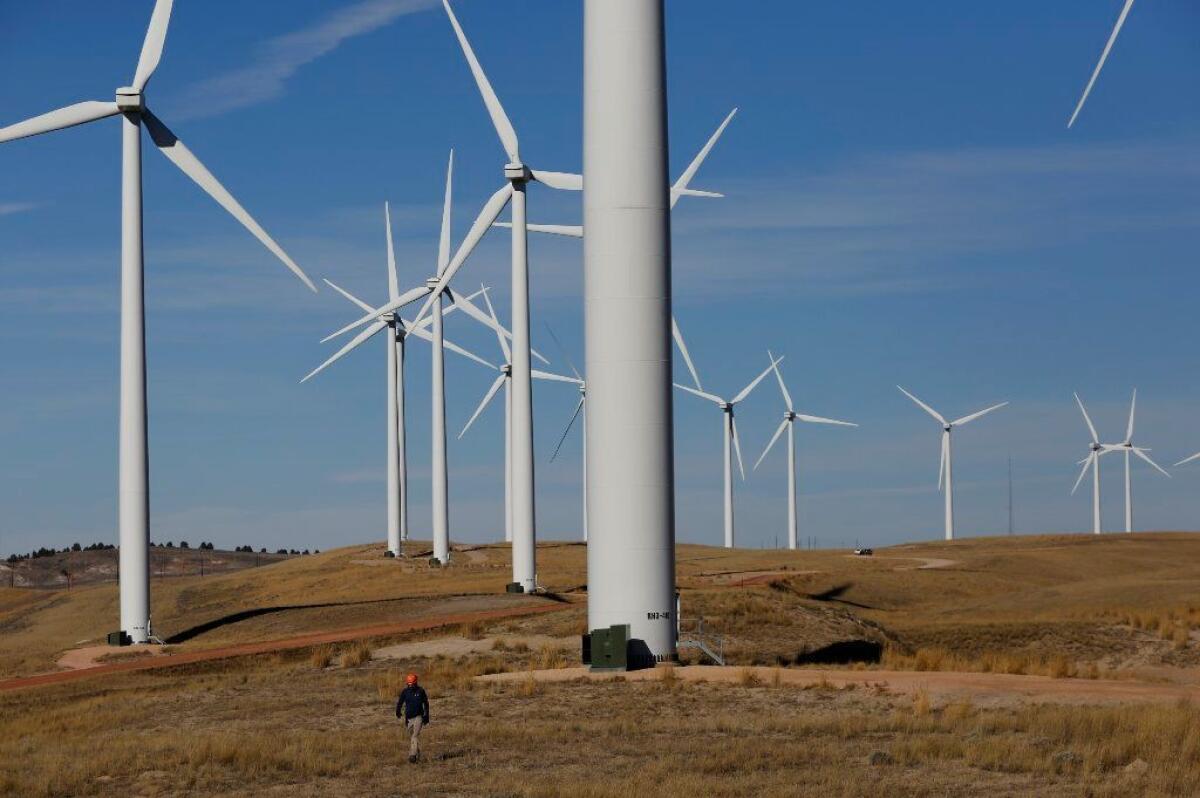Warren Buffett’s power company wants to charge Californians for upgrades to out-of-state coal plants

Homes and businesses in four Northern California counties get their electricity from an out-of-state company controlled by Warren Buffett — and soon Buffett’s company may be allowed to charge them for upgrades to coal plants in Wyoming and Colorado even though a California law prevents most utilities from investing in coal.
Buffett’s power company, PacifiCorp, has asked permission from California regulators to raise rates for its 45,000 customers in Del Norte, Modoc, Shasta and Siskiyou counties. PacifiCorp wants a 1.4% rate increase for residential customers, which would cover costs that include $440,000 worth of already-completed upgrades to two coal plants in Colorado and another in Wyoming.
The proposed rate hike is prompting objections from the Sierra Club, which has sparred with PacifiCorp over the future of its coal fleet and its efforts to partner with California on a regional energy-sharing initiative. The company has increased its use of renewable energy, but still sees a big role for coal in the coming years, despite a study it released this month showing that cleaner alternatives would in many cases be cheaper.
Christopher Thomas, a senior representative with the Sierra Club’s Beyond Coal Campaign, said PacifiCorp’s attempt to charge Californians for coal plant upgrades is a sign the company can’t be trusted to work with the Golden State to reduce planet-warming emissions.
“PacifiCorp has a history of fighting transparency on their coal fleet costs, spending a lot of money that then has the effect of prolonging the life of those coal plants,” Thomas said.
A 2006 California law blocked most utilities from continuing to make long-term investments in coal. But an exception in the law has allowed PacifiCorp, which is based in Portland, Ore., and has 1.9 million customers across six Western states, to keep investing in its coal fleet, since it has such a small footprint in California.
Warren Buffett is building up a ‘recession resistant’ energy powerhouse »
Despite that exception, the Sierra Club is asking the California Public Utilities Commission to deny PacifiCorp’s requested rate hike. The group has argued that PacifiCorp should have known years ago that the coal plants in question were uneconomic and shut them down rather than pay for pollution-control upgrades.
PacifiCorp has countered that it needed those upgrades to comply with federal clean air rules. Spokesman Scott Bolton described the Sierra Club’s argument as “a case of Monday morning quarterbacking.”
Etta Lockey, vice president of regulation for PacifiCorp subsidiary Pacific Power, said the Sierra Club is “using what we know today to make arguments about investment decisions that we made six, seven years ago.” PacifiCorp’s prudent financial management, she said, has allowed for a “remarkably small rate request” in California and kept costs low for the company’s customers in Idaho, Oregon, Utah, Washington and Wyoming.

The Utility Reform Network, a San Francisco-based ratepayer watchdog, has urged the California Public Utilities Commission to do a “more forceful review” of PacifiCorp’s future coal investments before allowing a share of those costs to be charged to California residents, staff attorney Matthew Freedman said. The watchdog group hasn’t analyzed PacifiCorp’s past investments in detail, but generally supports the Sierra Club’s position.
“They’re shining a light on spending that has gone completely under the radar,” Freedman said.
The three coal plants at the heart of the Sierra Club’s arguments — the Craig and Hayden plants in Colorado, and the Jim Bridger plant in Wyoming — have especially poor economics, said Robert Godby, director of the Center for Energy Economics and Public Policy at the University of Wyoming. That’s because they mostly burn coal from local mines near the facilities rather than cheaper coal from Wyoming’s Powder River Basin.
Although PacifiCorp probably knew those power plants would become noncompetitive eventually, Godby said, it would have been difficult for the company to see how quickly that reckoning might come.
“I think a lot of people were taken aback by the decline in coal and how quickly it happened from 2014 through 2016,” Godby said. “The Sierra Club is arguing with the benefit of hindsight.”
Coal plants fuel political controversy
The dispute over the proposed rate hike is only the latest skirmish between PacifiCorp and the Sierra Club, the country’s largest environmental group.
The Sierra Club has been pushing PacifiCorp for years to scrutinize the economics of its coal fleet more closely. That battle led to the company releasing the results of a study earlier this month showing it could reduce costs by closing some coal plants and replacing them with cleaner options, including solar and wind power.
The falling costs of renewable energy and natural gas have made it difficult for coal to compete in energy markets, and PacifiCorp has already indicated it will shut down nearly half its coal fleet over the next 15 years. The company, which is owned by Buffett’s Berkshire Hathaway Energy, also announced plans last year to invest $3.5 billion in wind power.
But coal still accounts for more than half of PacifiCorp’s energy mix. And despite the possible cost savings, shutting down too many coal plants too quickly could increase the likelihood of power outages, said Rick Link, PacifiCorp’s vice president of resource strategy and acquisition.
“Right now we are in the middle of the process of trying to find what the remedies to those reliability problems might look like,” Link said.
PacifiCorp’s reliance on coal has been a sticking point for some California lawmakers debating a regional energy-sharing plan. The proposal, which has been debated in Sacramento the last three years, would expand the nonprofit agency that runs most of California’s power grid to oversee electric utilities in other Western states, possibly including PacifiCorp.
Supporters, including outgoing Gov. Jerry Brown and several major environmental groups, say an integrated regional power grid would make it easier for California to share excess solar power with its neighbors and to import cheap wind energy from Wyoming or New Mexico. They say a regional grid would dramatically lower the costs of eliminating fossil fuels by making it easier for climate-friendly energy to flow across state lines.

PacifiCorp’s recent coal study should reassure the Sierra Club and other critics who fear a regional grid would backfire, said Carl Zichella, director of Western transmission for the Natural Resources Defense Council.
Critics worry PacifiCorp may be able to extend the life of its coal plants by selling electricity into California. But the economics of the coal plants will look even worse when they have to compete against solar and wind farms that don’t pay for fuel, Zichella said.
“If they’re increasingly uneconomic now, when they have to compete against zero-marginal-cost resources, they’re just completely losing,” he said.
The California Independent System Operator, which runs the power grid for most of the state, released a study finding California could save $1.5 billion a year through a fully unified Western power grid.
But the proposal has faced opposition in Sacramento. California would have to give up sole control of the grid operator, which critics say could give lawmakers in Utah and Wyoming an avenue to influence California’s energy mix.
Lawmakers move to add other states to oversight of California’s electric grid »
It’s unclear if Assemblymember Chris Holden, a Pasadena Democrat who chairs the state Assembly’s utilities and energy committee, will introduce another regional grid bill in 2019, as he did the last two years. Kellie Smith, the committee’s chief consultant, said Holden “still considers regionalization an absolute priority,” but may be too focused on wildfire-related issues to spend much time on regional grid discussions next year.
In the meantime, a growing number of Western utilities are joining a more limited energy-sharing venture led by California. The California Independent System Operator says its Energy Imbalance Market has saved participants more than $500 million and avoided 314,000 metric tons of planet-warming carbon dioxide emissions since it launched in 2014.
The market’s eight participants include PacifiCorp and another Berkshire Hathaway-owned utility, Nevada’s NV Energy. Six more utilities will join in the next few years, including the Los Angeles Department of Water and Power and Public Service Company of New Mexico, which announced plans to join this week.
Twitter: @Sammy_Roth
More to Read
Inside the business of entertainment
The Wide Shot brings you news, analysis and insights on everything from streaming wars to production — and what it all means for the future.
You may occasionally receive promotional content from the Los Angeles Times.











